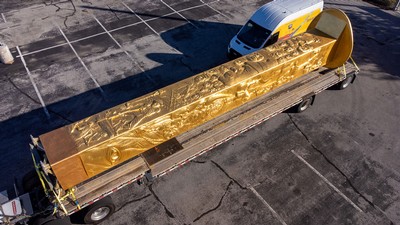USU History Prof Offers Context in Documentary About Dramatic Pioneer Trek
Robert McPherson, professor of history at USU-Eastern Blanding, appears in a new KBYU-TV documentary about the 1880 Hole in the Rock expedition.
Words often seem inadequate to fully describe one of the most harrowing episodes of the pioneer colonization of Utah — the Hole in the Rock expedition of 1880.
Exhaustion, despair, doggedness, ingeniousness. “It’s just a very dramatic story,” said Robert McPherson, a USU history professor at USU-Eastern Blanding. “You can’t help but feel for the people going through it.”
It, in this case, is what McPherson calls the “engineering feat” that allowed a group of Mormon pioneers — 83 wagons, 250 individuals and more than 1,000 head of livestock — to pick-ax their way down a sheer sandstone cliff and descend into the Colorado River gorge. For the first time, words will be replaced in a new documentary with computer images and reenactment of the event.
McPherson, a longtime student of southeastern Utah’s landscape and culture, appears this week in the documentary “Hole in the Rock Expedition,” filmed and produced by KBYU-TV. The documentary premiered earlier this month in Bluff, the tiny burg settled by the pioneers. It will be rebroadcast at 4:30 p.m. Saturday on Channel 11. KBYU is the Public Broadcasting Service (PBS) member at Brigham Young University.
McPherson praises the documentary as well-researched and an accurate portrayal of the trek, which led pioneer families from Cedar City and Parowan over 250 miles to confront the towering, sheer cliffs of what is now Glen Canyon. They discovered the only way to descend the sheer sandstone cliff was through what was indeed a hole in the rock -- a narrow, boulder-filled crevice barely wide enough for a man to pass through. They blasted and hacked their way down, “actually building a road on the side of the canyon wall,” said McPherson. “Through computer animation, the documentary shows you how they did it. “
While interviews of the pioneers’ descendants, computer-imaged reconstruction of the road and the on-location reenactment provide details of the struggle, McPherson helps put the event in the context of history. “I guess you could call me the objective voice,” he said.
McPherson said several reasons prompted the early Utahns, at the behest of John Taylor, then president of the Church of Jesus Christ of Latter-day Saints, to advance into what trek leader Platt Lyman described as “certainly the worst country I ever saw.” McPherson himself describes the area as “unforgiving” and “a blank spot on the map.” Indeed, he adds, this wild country that now contains Bluff and Blanding was “one of the last places in the United States where you really have the pioneer effort coming in and establishing a city.”
The pioneers, said McPherson, sought to establish a foothold in this area that was home to native American, but also plenty of outlaws. Plus, southeastern Utah was already drawing others not of the Mormon faith — cattle ranchers, miners and other land-seekers moving west from Colorado.
“Part of the church’s thinking was, ‘We need to stake a claim. This is Utah and we want to keep this a place for LDS people. We don’t want to lose our influence’,” he said.
McPherson is the author of more than 15 books on southwestern Utah, particularly its Native American culture. They include A Navajo Legacy: The Life and Teachings of John Holiday (University of Oklahoma Press, reprint 2011) and Mapping the Four Corners: Narrating the Hayden Survey of 1875 (University of Oklahoma Press ,2016, with Susan Neel, associate history professor at USU-Eastern Price).
The documentary, hosted by author Gerald Lund, was directed by BYU’s Rob Sibley. A KBYU spokesperson said the document will be broadcast again in March and is available on DVD with a $60 donation to the public TV station.
Related links:
Robert McPherson
Hole in the Rock Documentary Showings
Writer and contact: Janelle Hyatt, 435-797-0289, Janelle.Hyatt@usu.edu
This narrow crevice, now known as Hole in the Rock, was hacked and blasted by pioneers in 1880 to allow passage of 83 wagons down 2,000-foot cliffs into the Colorado River gorge. (Photo courtesy Todd Blackens, KBYU-TV)
TOPICS
Faculty 307stories History 139storiesComments and questions regarding this article may be directed to the contact person listed on this page.








